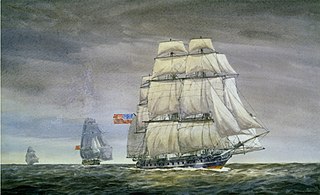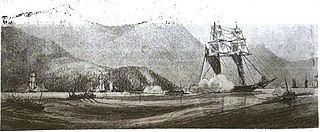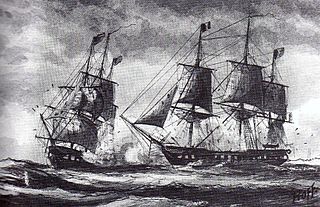Related Research Articles

The third USS Boston was a 32-gun wooden-hulled, three-masted frigate of the United States Navy. Boston was built by public subscription in Boston under the Act of 30 June 1798. Boston was active during the Quasi-War with France and the First Barbary War. On 12 October 1800, Bostonengaged and captured the French corvette Berceau. Boston was laid up in 1802, and considered not worth repairing at the outbreak of the War of 1812. She was burned at the Washington Naval Yard on 24 August 1814 to prevent her capture by British forces.

USS Adams was a 28-gun (rated) sailing frigate of the United States Navy. She was laid down in 1797 at New York City by John Jackson and William Sheffield and launched on 8 June 1799. Captain Richard Valentine Morris took command of the ship.

USS Constellation was a nominally rated 38-gun wooden-hulled, three-masted frigate of the United States Navy.
The first USS Eagle, a schooner, was built at Philadelphia, Pennsylvania, in 1798, and commissioned in the Revenue Cutter Service under the command of Captain H. G. Campbell, USRCS.
USS Ganges was a man-of-war in the United States Navy during the Quasi-War with France.

USS Experiment was a schooner in the United States Navy during the Quasi-War with France.
The first USS Norfolk was a brig in the United States Navy during the Quasi-War with France.

L'Insurgente was a 40-gun Sémillante-class frigate of the French Navy, launched in 1793. During the Quasi War with the United States, the United States Navy frigate USS Constellation, with Captain Thomas Truxtun in command, captured her off the island of Nevis. After her capture she served in the United States Navy as USS Insurgent, patrolling the waters in the West Indies. In September 1800 she was caught up in a severe storm and was presumed lost at sea.

USS Pickering was a brig, the 1st brig built for the UCRC Service, in the United States Revenue Cutter Service and then the United States Navy during the Quasi-War with France. She was named for Timothy Pickering, then the Secretary of State.
The first USS George Washington was a frigate in the United States Navy. She was named after United States Founding Father and President George Washington.
The second USS Delaware was a ship which served in the United States Navy during Quasi-War with France.
The second USS General Greene was a frigate in the United States Navy during the Quasi-War with France.
USS Merrimack, was a ship launched by an Association of Newburyport Shipwrights and presented to the Navy in 1798. She was the first ship of the Navy to be named for the Merrimack River. She saw action in the Quasi-War.
USS Portsmouth was constructed for the United States Navy in 1798 by master shipbuilder James Hackett to a design of Josiah Fox at what is now Badger's Island in Kittery, Maine, directly across the Piscataqua River from Portsmouth, New Hampshire. She was built with funds contributed by the citizens of Portsmouth.
Samuel Barron was a United States Navy officer. He was an older brother of Commodore James Barron, also a US Navy officer.
USS Augusta was a brig purchased by the US Navy on 30 June 1799 at Norfolk, Virginia. She mistakenly went to Trenton, New Jersey arriving on 13 September, she was then ordered to Marcus Hook, Pennsylvania for inspection by naval constructor Joshua Humphreys to see if the transport would be suitable for use as a warship. Capt. Bird was replaced by Lieutenant Archibald McElroy on the 13th. Humphreys approved and fitting out began in September. She was placed in commission for service in the Quasi-War with France sometime late in 1799.
USS Richmond was a brig purchased for the US Navy in 1798 by the citizens of Richmond, Petersburg, Manchester and Norfolk, Virginia, while being built at Norfolk as Augusta for a Mr. Myers. Renamed Richmond, she was fitted out in the fall of that year and in December stood out from Hampton Roads for the Caribbean with Captain Samuel Barron in command for service in the Quasi-War with France.
The first USS Patapsco was a sloop in the United States Navy.
USRC Scammel or sometimes referred to as Scammel II was a revenue cutter built in 1798 to serve in the Quasi-War with France. After completion she was transferred to the U.S. Navy and served in the West Indies naval squadron commanded by Commodore John Barry. While in Revenue-Marine service her captain was John Adams. In a letter dated 20 May, 1799 Navy Secretary Benjamin Stoddert notified the Treasury Secretary that he should consider her to be officially transferred to the U.S. Navy. In U.S. Navy service her first captain was Lieutenant Mark Fernald. She assisted the sloop USS Portsmouth in the surrender of the French navy ship Hussar August 20-22, 1799. Arrived in New York late September, 1799. She was ordered to St. Kitts on 16 October, 1799. After the war, the Navy retained Scammel until it was sold in 1801.
The Connecticut was a sailing frigate built by Seth Overton at Chatham, Conn. and launched 6 June 1799 at Middletown, Conn. During outfitting, probably on or just before 7 July she foundered. She was refloated. She sailed 15 Oct. 1799 under the command of Captain Moses Tryon for the Guadaloupe Station, arriving off Puerto Rico on 28 October. She cruised in the West Indies for a year during the Quasi-War with France, protecting American commerce from French privateers. Connecticut's successful career was highlighted by the capture of four privateers and the recapture of seven American merchantmen. On 7 November, 1799 she recaptured a schooner captured 15 days earlier. On 6 December she recaptured brig "Penelope" captured by French privateer "Fleur de Mair" on 3 December. On 29 December she captured off Point Petre French privateer brig "Conqueror of Italy", the most successful privateer operating out of Guadeloupe having captured 200 American merchant ships. "Conquest of Italy" was put in service as a tender for USS Constellation. On 14 January, 1800 She fired upon a privateer but it found shelter by a fort on Demerara, later that day she chased a ship ashore at Deseada which bilged and sank. On 28 April, with USS Richmond, she recaptured Thomas Chalkley. 1 June she captured privateer schooner "Le Piege" off Descada, and on 3 July recaptured brig "Martha and Mary" on the north side of St. Kitts. On 5 June captured privateer schooner "La Unite". On 17 June recaptured a schooner off Guadalupe. On 15 July, with USS Philadelphia, captured French Letter of Marque ketch "Le Chouchou". Arrived at New London, Conn., 18 Oct. 1800. Capt. Richard Derby was ordered to replace Capt. Tryon on 1 November. In a letter dated 20 February to Josiah Parker, Chaiman of the Commitee on Naval Affairs, Navy Secretary Stoddert recommended selling her. Connecticut was sold at New York in 1801 for $19,300.
References
- ↑ Palmer, Michael A. (1987), Stoddert's War: Naval Operations during the Quasi-war with France 1798–1801.
- ↑ "Naval Documents related to the Quasi-War Between the United States and France Volume 2 Part 1 of 3 Naval Operations November 1798 to March 1799" (PDF). U.S. Government printing office via Imbiblio. Retrieved 2 March 2024.
- ↑ "Naval Documents related to the Quasi-War Between the United States and France Volume 2 Part 2 of 3 Naval Operations November 1798 to March 1799 January-February, 1799 Pg. 227" (PDF). U.S. Government printing office via Imbiblio. Retrieved 2 March 2024.
- ↑ "Naval Documents related to the Quasi-War Between the United States and France Volume 3 Part 2 of 4 Naval Operations November 1798 to March 1799, June, 1799 Pg. 492" (PDF). U.S. Government printing office via Imbiblio. Retrieved 18 April 2024.
- ↑ "Early history of the U. S. Revenue Marine Service or (U.S. Revenue Cutter Service) 1798 to 1854 page 18" (PDF). R. L. Polk printing via Mediadefence.gov. Retrieved 15 April 2024.
- ↑ "Naval Documents related to the Quasi-War Between the United States and France Volume 3 Part 2 of 4 Naval Operations April 1799 to July 1799, May, 1799 Pg. 327" (PDF). U.S. Government printing office via Imbiblio. Retrieved 15 April 2024.
- ↑ "Naval Documents related to the Quasi-War Between the United States and France Volume 2 Part 4 of 4 Naval Operations April 1799 to July 1799 July Pg. 507 and 508" (PDF). U.S. Government printing office via Imbiblio. Retrieved 29 April 2024.
- ↑ "Naval Documents related to the Quasi-War Between the United States and France Volume Part 3 of 3 Naval Operations August 1799 to December 1799, December Pg. 559" (PDF). U.S. Government printing office via Imbiblio. Retrieved 3 June 2024.
- ↑ "Naval Documents related to the Quasi-War Between the United States and France Volume Part 1 of 4 Naval Operations January to May, 1800, Front Matter January Pg. 69" (PDF). U.S. Government printing office via Imbiblio. Retrieved 6 June 2024.
- ↑ "Naval Documents related to the Quasi-War Between the United States and France Volume Part 2 of 4 Naval Operations January to May, 1800, February, 1800-March, 1800 Pg. 227" (PDF). U.S. Government printing office via Imbiblio. Retrieved 20 June 2024.
- ↑ "Naval Documents related to the Quasi-War Between the United States and France Volume Part 2 of 4 Naval Operations January to May, 1800, February, 1800-March, 1800 Pg. 351" (PDF). U.S. Government printing office via Imbiblio. Retrieved 2 July 2024.
- ↑ "Naval Documents related to the Quasi-War Between the United States and France Volume 6 Part 1 of 4 Naval Operations June to November, 1800, June 1800 Pg. 66" (PDF). U.S. Government printing office via Imbiblio. Retrieved 25 July 2024.
- ↑ "Naval Documents related to the Quasi-War Between the United States and France Volume 6 Part 1 of 4 Naval Operations June to November, 1800, June 1800 Pg. 67" (PDF). U.S. Government printing office via Imbiblio. Retrieved 25 July 2024.
- ↑ Naval Documents related to the Quasi-War Between the United States and France (PDF). Vol. VI Part 2 of 4: Naval Operations June to November 1800, July-August 1800. U.S. Government Printing Office. p. 229. Retrieved 22 August 2024– via Ibiblio.
- ↑ Naval Documents related to the Quasi-War Between the United States and France (PDF). Vol. VI Part 2 of 4: Naval Operations June to November 1800, July-August 1800. U.S. Government Printing Office. p. 220. Retrieved 21 August 2024– via Ibiblio.
- ↑ Naval Documents related to the Quasi-War Between the United States and France (PDF). Vol. VI Part 2 of 4: Naval Operations June to November 1800, July-August 1800. U.S. Government Printing Office. pp. 409–410. Retrieved 4 September 2024– via Ibiblio.
- ↑ Naval Documents related to the Quasi-War Between the United States and France (PDF). Vol. VI Part 2 of 4: Naval Operations June to November 1800, July-August 1800. U.S. Government Printing Office. p. 496. Retrieved 10 September 2024– via Ibiblio.
- ↑ Naval Documents related to the Quasi-War Between the United States and France (PDF). Vol. VI Part 2 of 4: Naval Operations June to November 1800, July-August 1800. U.S. Government Printing Office. p. 540. Retrieved 13 September 2024– via Ibiblio.
![]() This article incorporates text from the public domain Dictionary of American Naval Fighting Ships .
This article incorporates text from the public domain Dictionary of American Naval Fighting Ships .